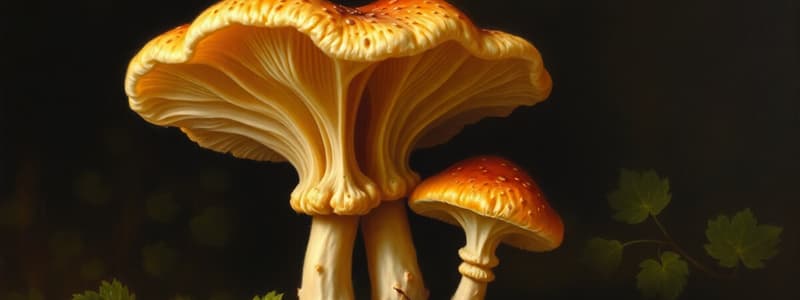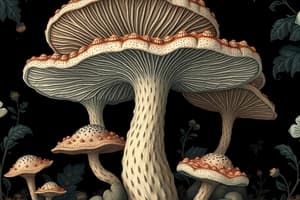Podcast
Questions and Answers
What is a key characteristic that distinguishes fungi from plants?
What is a key characteristic that distinguishes fungi from plants?
- Fungi have chlorophyll.
- Fungi have cell walls made of chitin. (correct)
- Fungi reproduce exclusively sexually.
- Fungi are autotrophic.
Which statement accurately describes the difference between fungi and bacteria?
Which statement accurately describes the difference between fungi and bacteria?
- Bacteria are heterotrophic, while fungi are autotrophic.
- Fungi are prokaryotic, while bacteria are eukaryotic.
- Bacteria have chitin in their cell walls, fungi do not.
- Fungi have sterols in their membranes, while bacteria lack sterols. (correct)
How do septate hyphae differ from non-septate hyphae?
How do septate hyphae differ from non-septate hyphae?
- Septate hyphae have walls known as septa. (correct)
- Septate hyphae are unicellular.
- Non-septate hyphae are primarily found in yeasts.
- Non-septate hyphae contain walls between cells.
In which form do fungi primarily reproduce asexually?
In which form do fungi primarily reproduce asexually?
Which of the following terms describes a collection of hyphae that becomes visible?
Which of the following terms describes a collection of hyphae that becomes visible?
What are mycorrhizae primarily known for?
What are mycorrhizae primarily known for?
Which characteristic is true of yeast compared to mold?
Which characteristic is true of yeast compared to mold?
Which of the following best describes saprotrophic fungi?
Which of the following best describes saprotrophic fungi?
How are fungi classified based on dimorphism?
How are fungi classified based on dimorphism?
What roles do lichen play in their symbiotic relationships?
What roles do lichen play in their symbiotic relationships?
What distinguishes the asexual reproduction process in fungi from sexual reproduction?
What distinguishes the asexual reproduction process in fungi from sexual reproduction?
Which fungal phylum is characterized by septated hyphae and contains the majority of woody edible mushrooms?
Which fungal phylum is characterized by septated hyphae and contains the majority of woody edible mushrooms?
Which fungal disease is also known as 'Summer flu' and primarily affects the lower respiratory system?
Which fungal disease is also known as 'Summer flu' and primarily affects the lower respiratory system?
What is the primary method through which Microsporidia fungi enter host cells?
What is the primary method through which Microsporidia fungi enter host cells?
Which treatment is commonly used for Candidiasis, particularly for vulvovaginitis?
Which treatment is commonly used for Candidiasis, particularly for vulvovaginitis?
What is a characteristic feature of Zygomycota, particularly regarding its reproduction?
What is a characteristic feature of Zygomycota, particularly regarding its reproduction?
Which of the following are symptoms associated with Coccidioidomycosis, frequently called 'Valley fever'?
Which of the following are symptoms associated with Coccidioidomycosis, frequently called 'Valley fever'?
Which condition is NOT typically associated with Candida albicans?
Which condition is NOT typically associated with Candida albicans?
Which fungal phylum is known for being obligate symbiotes with a significant role in the mycorrhizal association with plants?
Which fungal phylum is known for being obligate symbiotes with a significant role in the mycorrhizal association with plants?
What is the primary lesion type associated with Dermatophytosis caused by Trichophyton and Microsporum?
What is the primary lesion type associated with Dermatophytosis caused by Trichophyton and Microsporum?
Flashcards
Fungal Asexual Reproduction
Fungal Asexual Reproduction
Fungi reproduce asexually by generating spores that develop into genetically identical offspring, a faster process than sexual reproduction.
Fungal Sexual Reproduction
Fungal Sexual Reproduction
Involves the fusion of nuclei from different strains of the same species, leading to diverse offspring.
Chytridiomycota
Chytridiomycota
Oldest and simplest fungi, mostly aquatic. Notable for obligate aquatic lifestyle
Fungi vs. Plants
Fungi vs. Plants
Signup and view all the flashcards
Zygomycota
Zygomycota
Signup and view all the flashcards
Ascomycota
Ascomycota
Signup and view all the flashcards
Fungi vs. Bacteria
Fungi vs. Bacteria
Signup and view all the flashcards
Fungal Forms
Fungal Forms
Signup and view all the flashcards
Basidiomycota
Basidiomycota
Signup and view all the flashcards
Ergotism
Ergotism
Signup and view all the flashcards
Hyphae
Hyphae
Signup and view all the flashcards
Mycelium
Mycelium
Signup and view all the flashcards
Histoplasmosis
Histoplasmosis
Signup and view all the flashcards
Saprotroph
Saprotroph
Signup and view all the flashcards
Dermatophytosis
Dermatophytosis
Signup and view all the flashcards
Mycorrhizae
Mycorrhizae
Signup and view all the flashcards
Candidiasis
Candidiasis
Signup and view all the flashcards
Lichens
Lichens
Signup and view all the flashcards
Fungal Dimorphism
Fungal Dimorphism
Signup and view all the flashcards
Asexual Reproduction (Fungi)
Asexual Reproduction (Fungi)
Signup and view all the flashcards
Study Notes
Fungal Characteristics
- Fungi lack chlorophyll and cannot photosynthesize, making them heterotrophic (obtain energy from other sources) unlike plants which are autotrophic (produce their own food).
- Fungi have cell walls made of chitin, differentiating them from plant cell walls made of cellulose.
- Fungi are eukaryotic, possessing a nucleus and membrane-bound organelles, unlike prokaryotic bacteria.
- Fungi membranes contain sterols, a characteristic absent in bacteria. Fungal cell walls lack peptidoglycans, which are found in bacteria.
Fungal Morphology and Reproduction
-
Fungi can exist as either molds or yeasts.
-
Molds: Multicellular and aerobic, typically reproducing by forming airborne spores.
-
Yeasts: Unicellular and facultative anaerobes, capable of reproducing both sexually and asexually through budding or transverse division.
-
Hyphae: Thread-like filaments that absorb nutrients for the fungus. They can extend and break off to form new hyphae.
-
Mycelium: The interwoven mass of hyphae that forms the visible fungal structure.
-
Septate hyphae: Have walls (septa) separating individual cells.
-
Non-septate hyphae: Lack walls between cells, forming continuous tubes.
Fungal Nutrition
- Saprotrophs: Fungi that decompose dead organic matter.
- Parasites: Fungi that derive nutrients from living hosts, causing harm.
- Symbionts: Fungi that live in mutually beneficial relationships with other organisms.
Fungal Symbiotic Relationships
- Mycorrhizae: Symbiotic relationships between fungi and plant roots, enhancing nutrient uptake for the plant.
- Lichens: Symbiotic associations between fungi and algae or cyanobacteria.
Fungal Classification
- Fungi are classified based on several factors including dimorphism (the ability to exist in different forms depending on conditions).
- Dimorphism: Some fungi can switch between hyphae and yeast forms depending on temperature or location within a host.
Fungal Reproduction
- Asexual reproduction: A common method involving spore formation and subsequent germination to produce offspring genetically identical to the parent. A faster process than sexual reproduction.
- Sexual reproduction: Less common, involving the fusion of nuclei from two different mating strains of the same species.
Fungal Phyla (Examples)
- Chytridiomycota: Primarily aquatic, oldest and simplest fungi, non-septate.
- Glomeromycota: Non-septate, known for their symbiotic relationship with plant roots (endomycorrhizae) in 80% of plants.
- Zygomycota: Non-septate fungi involved in food spoilage and some plant diseases. Reproduce with zygospores (diploid zygotes).
- Ascomycota: Septate fungi, a vast group including many important food sources and plant pathogens. They reproduce with ascospores (within sac-like structures). Asexual reproduction also involves conidiospores.
- Basidiomycota: Septate fungi characterized by visible fruiting bodies (e.g., mushrooms). Their reproductive cycle involves basidiospores.
- Microsporidia: Non-septate, obligate intracellular parasites of animals, characterized by specialized polar tubules enabling fungal entry into host cells.
Fungal Diseases
- Ergotism: A medieval disease caused by fungus-contaminated rye.
- Histoplasmosis: A lung infection caused by Histoplasma capsulatum, often found in soil contaminated with bird or bat droppings.
- Dermatophytosis (Ringworm): Fungal infection of skin, hair, and nails, transmitted by direct contact and fomites (objects).
- Candidiasis (Thrush & Yeast Infections): Caused by Candida albicans, affecting mouth, throat, and the vulva/vagina.
- Coccidioidomycosis (Valley Fever): A respiratory infection caused by fungus in soil, common in desert regions.
Studying That Suits You
Use AI to generate personalized quizzes and flashcards to suit your learning preferences.
Description
Explore the fascinating world of fungi in this quiz that covers their unique characteristics and reproductive methods. Learn how fungi differ from plants and bacteria, and discover the various forms they take, including molds and yeasts. Test your knowledge on fungal morphology and traits!




